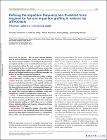| dc.contributor.author | O'REILLY, PETER | en |
| dc.contributor.author | KELLY, DANIEL | en |
| dc.date.accessioned | 2011-10-18T15:49:13Z | |
| dc.date.available | 2011-10-18T15:49:13Z | |
| dc.date.issued | 2011 | en |
| dc.date.submitted | 2011 | en |
| dc.identifier.citation | Cummins F, Reilly PO, Flannery O, Kelly D, Kenny P, Defining the impaction frequency and threshold force required for femoral impaction grafting in revision hip arthroplasty. A human cadaveric mechanical study., Acta Orthopaedica, 82, 4, 2011, 433-7 | en |
| dc.identifier.issn | 1745-3674 | en |
| dc.identifier.other | Y | en |
| dc.identifier.uri | http://hdl.handle.net/2262/60181 | |
| dc.description | PUBLISHED | en |
| dc.description.abstract | BACKGROUND AND PURPOSE:
The two most common complications of femoral impaction bone grafting are femoral fracture and massive implant subsidence. We investigated fracture forces and implant subsidence rates in embalmed human femurs undergoing impaction grafting. The study consisted of two arms, the first examining the force at which femoral fracture occurs in the embalmed human femur, and the second examining whether significant graft implant/subsidence occurs following impaction at a set force at two different impaction frequencies.
METHODS:
Using a standardized impaction grafting technique with modifications, an initial group of 17 femurs underwent complete destructive impaction testing, allowing sequentially increased, controlled impaction forces to be applied until femoral fracture occurred. A second group of 8 femurs underwent impaction bone grafting at constant force, at an impaction frequency of 1 Hz or 10 Hz. An Exeter stem was cemented into the neomedullary canals. These constructs underwent subsidence testing simulating the first 2 months of postoperative weight bearing.
RESULTS:
No femurs fractured below an impaction force of 0.5 kN. 15/17 of the femurs fractured at or above 1.6 kN of applied force. In the second group of 8 femurs, all of which underwent femoral impaction grafting at 1.6 kN, there was no correlation between implant subsidence and frequency of impaction. Average subsidence was 3.2 (1-9) mm.
INTERPRETATION:
It is possible to calculate a force below which no fracture occurs in the embalmed human femur undergoing impaction grafting. Higher impaction frequency at constant force did not reduce rates of implant subsidence in this experiment. | en |
| dc.format.extent | 433-7 | en |
| dc.language.iso | en | en |
| dc.relation.ispartofseries | Acta Orthopaedica | en |
| dc.relation.ispartofseries | 82 | en |
| dc.relation.ispartofseries | 4 | en |
| dc.rights | Y | en |
| dc.subject | Bioengineering | en |
| dc.subject | bone grafting | en |
| dc.subject | hip arthroplasty | en |
| dc.title | Defining the impaction frequency and threshold force required for femoral impaction grafting in revision hip arthroplasty. A human cadaveric mechanical study. | en |
| dc.type | Journal Article | en |
| dc.type.supercollection | scholarly_publications | en |
| dc.type.supercollection | refereed_publications | en |
| dc.identifier.peoplefinderurl | http://people.tcd.ie/kellyd9 | en |
| dc.identifier.peoplefinderurl | http://people.tcd.ie/poreilly | en |
| dc.identifier.rssinternalid | 75430 | en |
| dc.identifier.doi | http://dx.doi.org/10.3109/17453674.2011.594228 | en |
| dc.subject.TCDTheme | Next Generation Medical Devices | en |
| dc.identifier.rssuri | http://dx.doi.org/10.3109/17453674.2011.594228 | en |
| dc.identifier.orcid_id | 0000-0003-4091-0992 | en |




